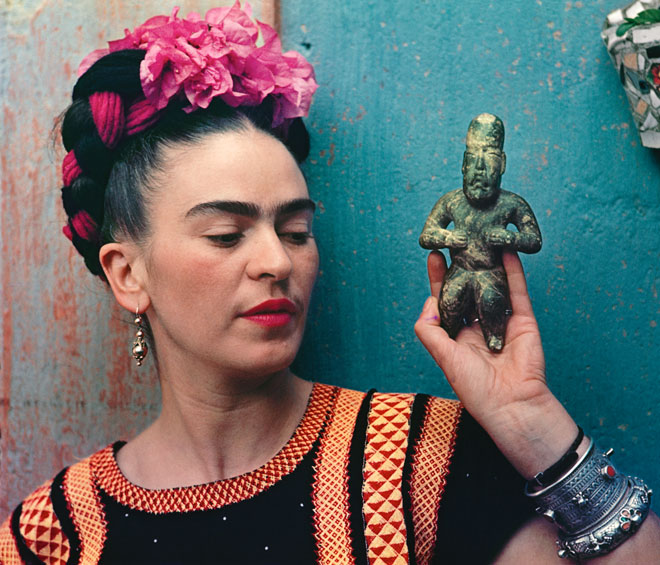
Victoria and Albert Museum, London
16 June – 4 November 2018
by ANNA McNAY
Everyone knows something of the tragic story of Frida Kahlo (1907-54) – the polio, contracted when she was six, which left her right leg thinner than her left and caused her to limp; the accident, when she was 18, the after-effects of which reverberated throughout the rest of her short life, forcing her to undergo multiple operations and spend much time bed bound; her tempestuous relationship and on-off marriage with the Mexican muralist Diego Rivera (1886-1957); her affairs with Russian revolutionary Leon Trotsky, as well as with various female friends; her now iconic monobrow and her unconventional and folkloric style of dress – and there is a flourishing yet morbid fascination with her tale. Children around the world wear flowery Frida-style hairpieces; teenage girls have Daft Punk Frida T-shirts; even grown men can be spotted with Frida socks. There are also numerous self-help-style inspirational books in which Kahlo stars as role-model-cum-heroine.
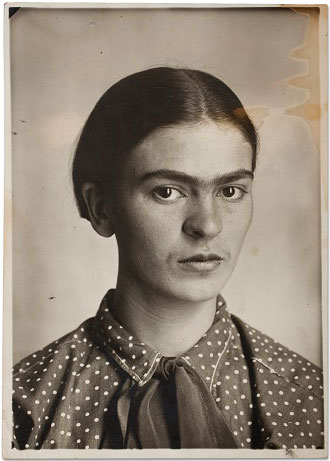
Frida Kahlo, c1926. Museo Frida Kahlo. © Diego Riviera and Frida Kahlo Archives, Banco de México, Fiduciary of the Trust of the Diego Riviera and Frida Kahlo Museums.
Thankfully, her artworks are recognisable, too – at least, her self-portraits are known through multiple reproductions, even if often distorted and graphicalised into a contemporary branded derivation. Sadly, encounters with the works themselves are rarer, and, having read reviews of this much-hyped and long-awaited blockbuster exhibition at the Victoria and Albert Museum, they were not something I was especially banking on encountering. The focus is, instead, on Kahlo’s biography and, principally, the treasure trove of artefacts and paraphernalia uncovered, when, in 2004, the seal was broken on the bathroom in her lifelong home Casa Azul (the Blue House, in Coyoacán, south of Mexico City – now the Museo Frida Kahlo), which, for 50 years following her death, had been kept locked, as dictated shortly before his death by Rivera. Nevertheless, true art fans needn’t despair or indeed avoid the exhibition altogether, for there are enough paintings to render the battle with the crowds worthwhile, even if you may ultimately leave with somewhat mixed feelings.
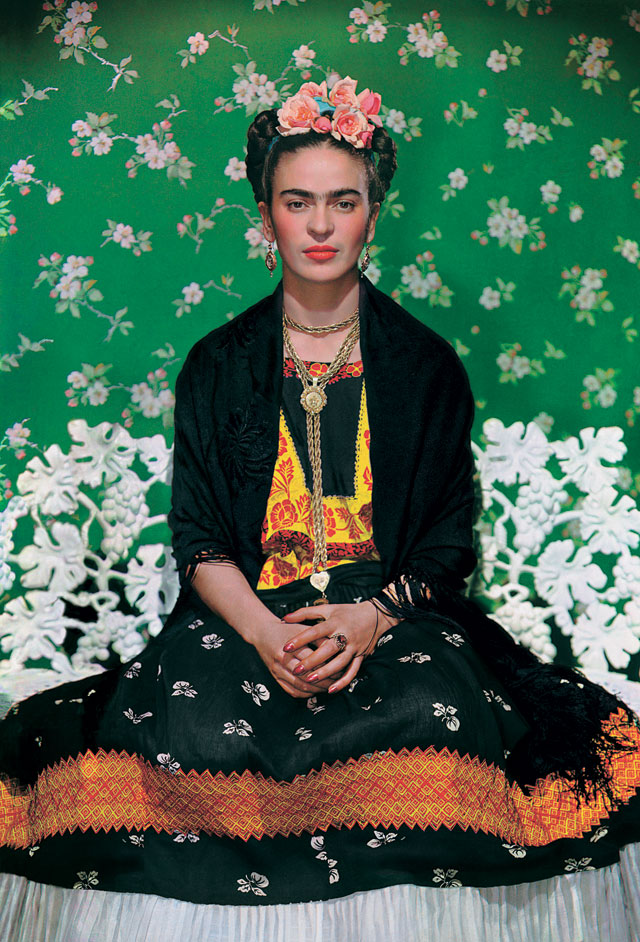
Frida on the bench, 1939, photograph by Nickolas Muray. © Nickolas Muray Photo Archives.
The exhibition opens with a long, narrow corridor – exceptionally bad design for what was deliberately conceived to be a crowd-pleaser – lined with photographs of Kahlo and her family, including one of the artist’s first communion in 1917, comically annotated in her own handwriting with the word “idiota”, and a significant portrait of her mother at the age of seven, with her family of Spanish/Indian descent, fully dressed in the Tehuana tradition, and thus disproving the myth that Kahlo’s own relationship with this traditional dress form began only after her meeting with Rivera in 1928. Fascinating as they all are, however, it is hard to see these images properly in the throngs, and I feel I would rather enjoy them in book form at home.
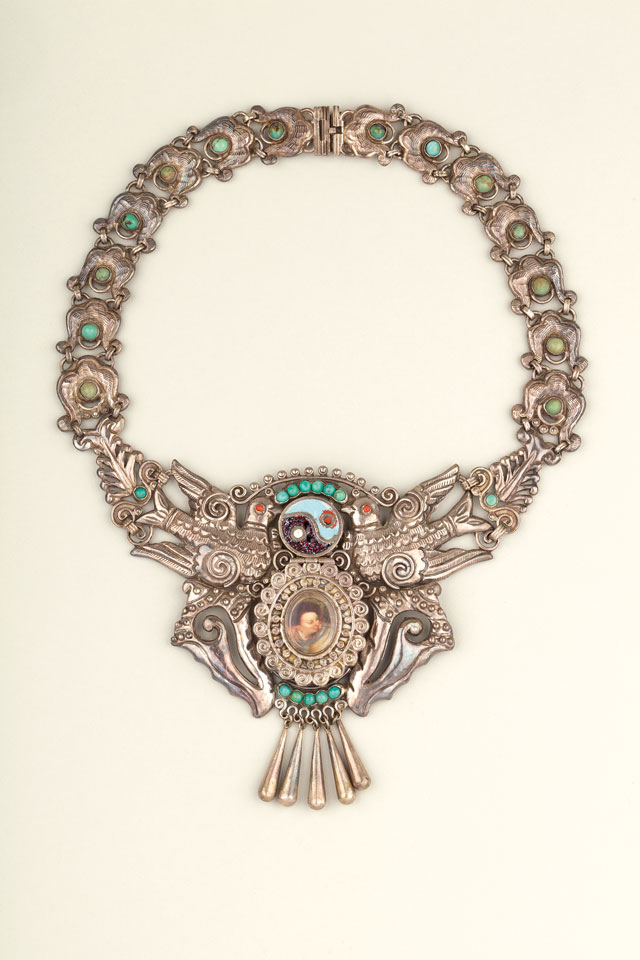
Necklace of silver, enamel, turquoise and coral with hinged compartment, made by Matilde Poulat, Mexico City, c1950. Museo Frida Kahlo. Photo: Javier Hinojosa. © Diego Riviera and Frida Kahlo Archives, Banco de México, Fiduciary of the Trust of the Diego Riviera and Frida Kahlo Museums.
There are some drawings in this first stretch, too, however, including Self-Portrait on the Borderline between Mexico and the United States (1932), documenting her first visit to what she came to term as “Gringolandia”, and La Libertad (c1946), a red chalk and pencil sketch for an unfinished painting, showing the Statue of Liberty with her torch replaced by a money bag and atomic bomb, depicting the threats of financial and military might. Despite forming strong friendships in the US, Kahlo frequently critiqued its politics and power.
Following a section aiming, with odd strains of piped birdsong, to evoke the atmosphere of Casa Azul – Kahlo’s house of birth, to which she and Rivera returned in the 1930s, and which became a hub for Mexico’s artistic, cultural and political elite, with visitors from all over the world – an interesting wall is hung with an array of votive paintings, or retablos as they are known in Mexico, typically painted on metal panels and hung in churches as expressions of thanks to the Virgin Mary and the saints. Kahlo collected such images and hung them in her home. These scenes of accident and illness inspired her in her work, where she, too, frequently exploited the narrative power of such a compression of space and time. Sadly, her drawing The Accident (1926) is only shown as a copy printed on the wall, but it clearly demonstrates her use of multiple perspectives to impart both detachment and horror. This technique can be seen throughout her work, not least in paintings such as The Two Fridas (1939), in which she doubles up her own image to give not just two alternative selves, but two alternative political and cultural scenarios.
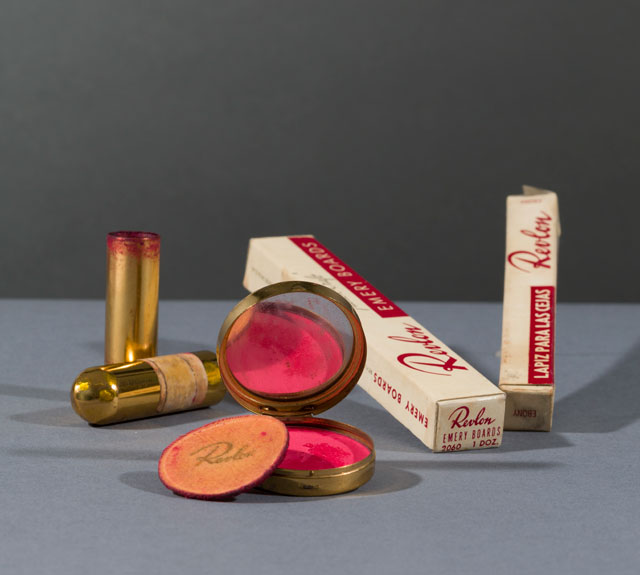
Revlon compact and powderpuff with blusher in Clear Red and Revlon lipstick in Everything’s Rosy; emery boards and eyebrow pencil in Ebony. Before 1954. Photo: Javier Hinojosa. © Diego Riviera and Frida Kahlo Archives, Banco de México, Fiduciary of the Trust of the Diego Riviera and Frida Kahlo Museums.
It is in this way, as the exhibition’s curators Claire Wilcox and Circe Henestrosa suggest in their introductory essay in the accompanying catalogue, that Kahlo’s clothing and art exist in a symbiotic relationship. As an artist, she was acutely aware of the iconographic significance of dress within the traditions of portraiture and she used costume in both her art and her self-presentation, never simply as ornament, but always laden with symbolic meaning. The Tehuana identity she adopted represented a tradition of strong women resisting subjugation, conquest and colonialisation – more than relevant in the revolutionary times in which Kahlo lived. Furthermore, beyond just her clothing, she also used her body metaphorically to represent the ruptured Mexican state. In one particularly revealing drawing, Kahlo exposes herself underneath her Tehuana costume – with mismatched limbs, a crumbling spine and a medical corset – and the handwritten words: “Appearances can be deceiving.” Beneath that colourful and floral facade, who knows how much pain she was feeling?
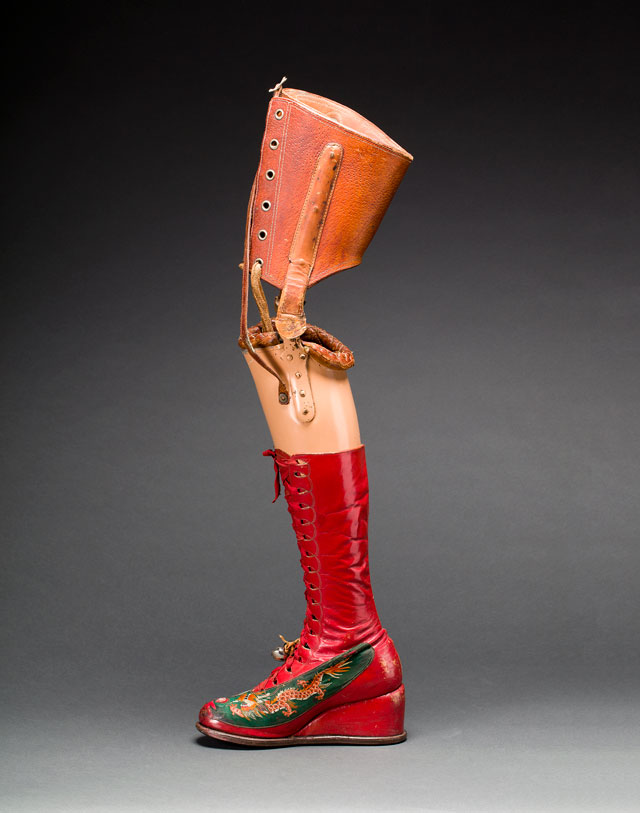
Prosthetic leg with leather boot. Appliquéd silk with embroidered Chinese motifs. Photo: Javier Hinojosa. Museo Frida Kahlo. © Diego Riviera and Frida Kahlo Archives, Banco de México, Fiduciary of the Trust of the Diego Riviera and Frida Kahlo Museums.
The strangest and most unsettling room in the exhibition goes some way to answering this question, by displaying not just her medical corsets (many of them beautifully hand-decorated), her crutches, her specially modified shoes and her prosthetic leg (her right leg was amputated beneath the knee to remove a gangrenous foot and, supposedly, save her life in 1953. Kahlo, however, never fully recovered from the operation and died a year later on 13 July 1954), but also a whole cocktail of pill bottles and typewritten clinical history notes. From the quantity and variety of drugs, it is evident how much she was suffering – one bottle contains Demerol, an addictive opioid, which Kahlo supposedly begged her dentist to prescribe to the point where he destroyed his prescription book rather than do so. The vitrines in this central space are designed like four-poster beds, with mirrors in their ceilings, as in Kahlo’s own bed chamber, to which she was so often confined, and in which she painted so many of her self-portraits (the genre comprising a third of her overall works).
Kahlo is often quoted as saying: “I am not sick, I am broken. But I am happy to be alive as long as I can paint.” It therefore seems more than just a little morbid to dwell so much on her sickness – even if the displays, perhaps all the more macabre as a result, also include such personal artefacts as lipsticks, hair pomades and nail varnishes (Revlon’s Lastron in frosted snow pink and frosted pink lightning, if you must know). Indeed, I overheard numerous visitors commenting on the uncomfortable sense of voyeurism and their own ambivalence about it all.
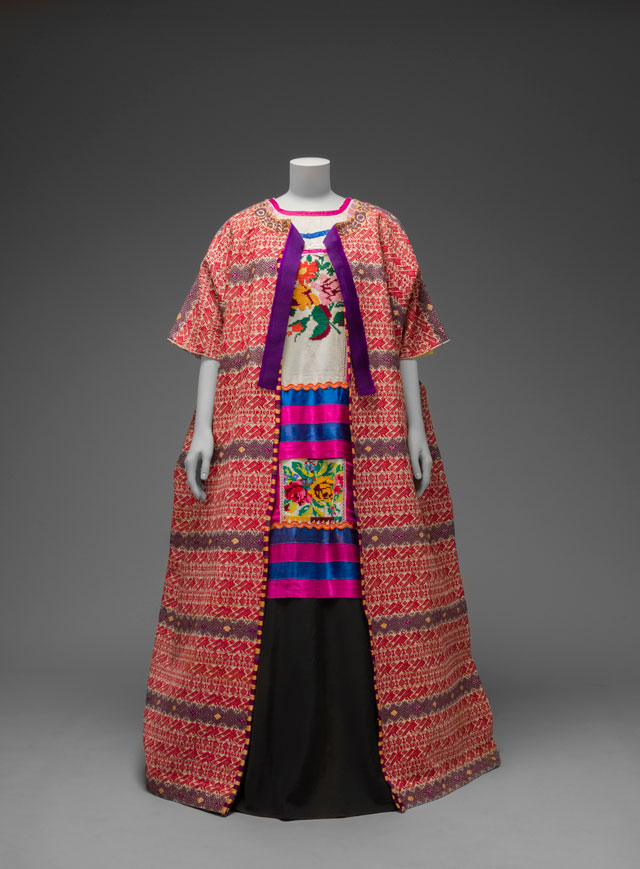
Guatemalan cotton coat worn with Mazatec huipil and plain floor-length skirt. Museo Frida Kahlo. © Diego Rivera and Frida Kahlo Archives, Banco de México, Fiduciary of the Trust of the Diego Riviera and Frida Kahlo Museums.
For me, the exhibition really begins in the final room, the centrepiece of which is a large showcase filled with mannequins, their grey heads shaped like Kahlo’s, parading her many costumes. It is not these that attract me, however, despite their gorgeous colours and materials, but it is the sight of an old friend hanging on the wall – Self-Portrait with Monkeys (1943). I say “old friend”, but we had never met before, and yet, in all my familiarity, it felt as if I had known the painting intimately for years. To be able to stand up close, “in the flesh”, and admire the individual strokes of paint creating the fur on each of the four pet spider monkey’s chests, as well as Kahlo’s eyelashes, is a joy worth any amount of pushing and shoving in the heat. I stand for a long while, unable to stop smiling, enjoying the individual expressions on each monkey’s face, and each one’s unique “hairstyle”, as well as the way in which Kahlo’s own braids mirror the long fingers of her beloved pets, known for the havoc they created in Casa Azul.
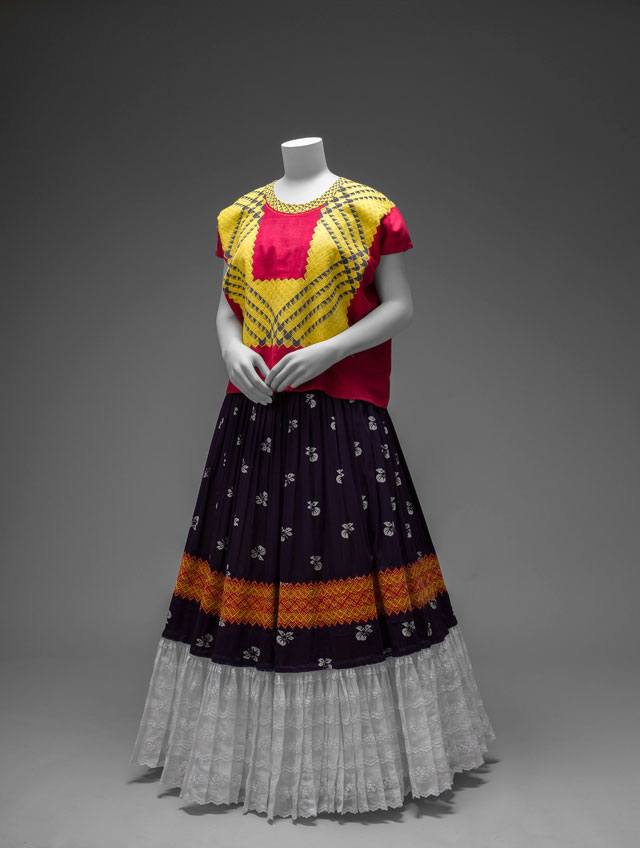
Cotton huipil with machine-embroidered chain stitch; printed cotton skirt with embroidery and holán. Ensemble from the Isthmus of Tehuantepec. Photo: Javier Hinojosa. © Diego Riviera and Frida Kahlo Archives, Banco de México, Fiduciary of the Trust of the Diego Riviera and Frida Kahlo Museums.
The exhibition closes with a Kahlo mannequin in a pink skirt and lace headdress, with her back to the gallery, reflected in a mirror, as if she were leaving the room, entering the mirror that has been her double for so long, passing through the portal, and escaping her mortal life of pain. The headdress, or resplandor, echoes that which her image is wearing in Self-Portrait (1948) – painted for one of her doctors – out of which her face peers, as trapped as the bird on the brooch beneath, tears studding her cheeks. Is she, we ask, as we leave the gallery, finally free? How can she be, while we continue so brazenly to intrude into her intimate, private space, as so many doctors did throughout her lifetime? Having had my own fair share of health problems, I know how it is to have your body violated, your sense of self stolen, your boundaries pitilessly disrespected, and to have to re-establish yourself in the face of continual setbacks and challenges, asserting and recreating your image of yourself, while, all the time, appearing smiling and successful, contented in the world. Indeed, appearances can be deceiving. Is it right for us, therefore, to perpetuate this violation into Kahlo’s personal space more than half a century after what ought to have been her ultimate escape?
As Kahlo’s biographer Hayden Herrera points out: “Although her paintings record specific moments in her life, all who look at them feel that Frida is speaking directly to them.”1 It is this allure, this familiarity, that, for better or worse, makes Kahlo the enduring icon that she is. It remains all the more important, then, as Oriana Baddeley concludes in her essay, which closes the catalogue, to remember that it was Kahlo who first created Frida.2 And this creation – and public artistic persona – ought to be respected, perhaps leaving a little of the private, hidden Kahlo as just that: private and hidden. At most, it seems subject matter for a dissertation or book, but the exhibition, for me, leaves something of a bad taste in my mouth.
References
1. Why Frida Kahlo Speaks to the 90s by Hayden Herrera, in the New York Times, 28 October 1990, page 3.
2. Frida Redressed by Oriana Baddeley, in Frida Kahlo: Making Herself Up, exhibition catalogue, Victoria and Albert Museum, 2018, page 186.